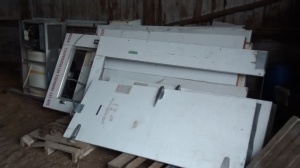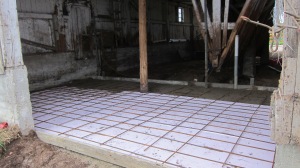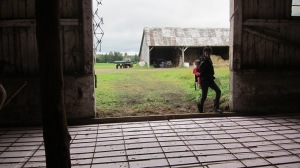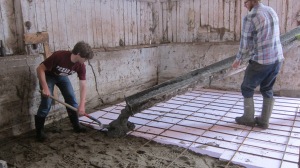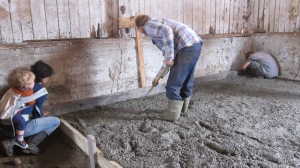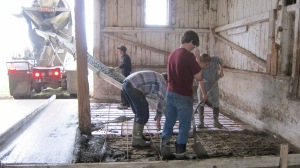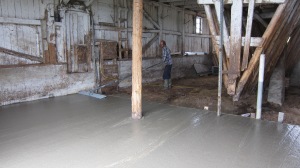You know what’s a lot more fun than it sounds : pouring concrete floors.
Given the number of outbuildings and the amount of space we now have, we decided the thing to do was to buy a walk-in freezer. We’ll save on the cost of renting freezer space, spare ourselves the inconvenience of getting to and from the warehouse, and we’ll be able to pack beef boxes as we go, and for shorter periods of time (as opposed to Paul freezing his hands off packing boxes in the freezer for eight consecutive hours).
Here’s our freezer, all in pieces. We’ll put it together once our own chest freezer is full (of sweet blanched garden goods!) or as the abattoir season draws nearer. An electrical professional will do the rest.
We bought sand, rebar, and some insulating foam. We made the form with 2 x 6s, shovelled in sand, laid the foam, put out the rebar, and used a level and some sidewalk chalk to mark the wall.
The guy backed in the truck, snapped the chute panels into place and let er rip. We all froze when it first started pouring out, I’d say, but the shovels got busy pretty fast. Wet cement was pushed into corners, along the wall, and shovelfuls were chucked to fill indents left by boots. Paul grabbed at the rebar, to try to centre it within the layer of cement.
Moving a long board back and forth, we started smoothing out the cement.
We smoothed until we got to one of the beams and started shovelling anew.
Plank and shovel. Plank and shovel.
Turns out that « washing the kitchen floor » trick, whereby you don’t trap yourself into a corner with nowhere to go but wet shiny floor, also applies to laying cement floors. Mopping and cementing, who knew.
Quick word to the wise : due to the caustic nature of wet concrete, skin can be burned by the contact. To prevent these chemical burns, it’s really quite advisable to wear gloves. Since Josée’s hands are still raw and about as soft as 80 grit sandpaper over a week later, she’s decided that, when working with new tools or materials in the presence of professionals (in this case the cement truck operator), she’ll do a quick scan of their own safety gear before jumping in. He was, for the record, wearing work gloves.
Paul smoothed over the area using a bull float (a big swiffer like tool). We’re hoping that the barn will eventually be able to house a bit of an on-site store. This was a solid first step at occupying the barn, which is remarkably full of strangely shaped, unusable nooks.
As everyone else was washing up tools, Danny tried out the mechanical float we rented, and proceded to propel himself off the machine and into the fresh cement surface. No pictures, unfortunately.
Not only is there a sizable mound of leftover sand,
but we also had extra cement, so a sandbox is in the making, and we poured and smoothed a bit of a basketball court at the back of the barn.
We all forgot to sign our names into the floor, so the true barn residents went ahead and did it.

